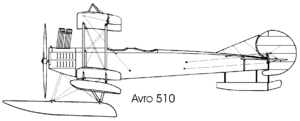Avro 510
| 510 | |
|---|---|
 | |
| Role | Racing and patrol seaplane |
| National origin | United Kingdom |
| Manufacturer | Avro |
| First flight | July 1914 |
| Primary user | Royal Naval Air Service |
| Number built | 6 |
| Variants | Avro 519 |

The Avro 510 was a two-seat racing seaplane designed by Avro to compete in the 1914 Circuit of Britain Race. It was a conventional two-bay biplane of greatly uneven span, equipped with two large central floats and two outriggers. The race was called off at the outbreak of the First World War, but the British Admiralty was aware of the type and ordered five examples, with modified floats and tail. In service, these proved completely unsuitable, and it was discovered that with a second person aboard, the aircraft could barely fly. In October 1915, the 510s in service were sent to Supermarine for modification and improvement, but by March the following year all were removed from service.[1]
Specifications
Data from Avro Aircraft since 1908 [2]
General characteristics
- Crew: one pilot
- Capacity: one observer or passenger
- Length: 38 ft (11.59 m)
- Wingspan: 63 ft (19.21 m)
- Height: ()
- Wing area: 564 ft² (52.4 m²)
- Empty weight: 2,080 lb (943 kg)
- Loaded weight: 2,800 lb (1,270 kg)
- Powerplant: 1 × Sunbeam Crusader [a] V-8 water-cooled engine, 150 hp (112 kW)
Performance
- Maximum speed: 70 mph (113 km/h)
- Rate of climb: 220 ft/min [b] (1.1 m/s)
- Endurance: 4 hr 30 min
See also
- Related development
Notes
a Most sources give the powerplant of the 510 as a Sunbeam Nubian, an engine that would not yet exist until all the 510s had been withdrawn from service in 1916. The Wolverhampton Museum of Industry website cites Eric Brew's Sunbeam Aero Engines and identifies the 510's engine as a Crusader.[3]
b Climb to 1000 ft (305 m) 4.5 minutes.[2]
References
- ↑ Jackson 1990, pp.136-138.
- 1 2 Jackson 1990, p.138.
- ↑ "Sunbeam: Side Valve Engines: The Crusader". Wolverhampton Museum of Industry. Archived from the original on 2008. Retrieved 2008-08-02.
- Jackson, A.J. (1990). Avro Aircraft since 1908. London: Putnam. ISBN 0-85177-834-8.
- Taylor, Michael J. H. (1989). Jane's Encyclopedia of Aviation. London: Studio Editions. p. 93.
External links
| Wikimedia Commons has media related to Avro aircraft. |